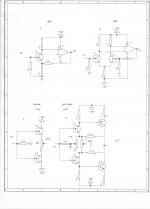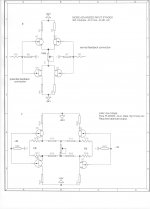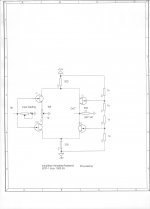Bob Pease was doing them in 1963, and Dick Burwen at least by 1966. Interestingly the little triangle symbol is pretty old in the analog computing world.
Thanks Scott. I nearly built an analogue computer many years ago, but then the Sinclairs came along.
Thanks Ray and Max. I did miss the typo.
The triangle symbol is what the computer defines as 'op amp' in the drawing program, but it can represent following gain stages as well.
Before the uA741, and LM301, we also had the uA702 and the uA709, both designed by Bob Widler, first with Fairchild, later with National.
Did you ever use any of the early mass produced devices (such as the 301 and 709, or even the 702 come to that) for audio when they appeared John. I imagine they seemed pretty remarkable at the time. Or was discrete audibly far superior even back then and taking into account the speakers and other hardware (and vinyl/tape) of the day.
Thanks for the insight John. Its interesting seeing on the one hand how far we have come in those intervening years and yet on the other how it is sometimes just a matter of degrees. I'm guessing that back then it was the ancillary's, the speakers, the cartridges etc that were the weak link in the chain... or am I wrong there... could a late 60's set up still excel today.
A late '60's set up (tubes) could be equal or better than most hi fi today. Solid state, then, like digital today, was the 'unknown frontier'.
My first builds of DiY preamplifiers and power amplifiers was with Germanium transistors, and the transistors was good, but circuit design and implementation was the prehistoric
I think it helps to look at the cart makers design trade-offs to see what this type of damping could do or help. For example, tracking -- some cart are under damped to get greater peak tracking at other expense. One under-damped oldie was the Decca cart. Others are over damped and all intended to work best with a particular arm characteristic or a standard arm --like maybe the SME......the cart is matched to the arm for critical damping... etc etc....
I could imagine if I were a cart maker, I could damp it with a load R and under damp it mechanically and get some slight improvement in a particular parameter -- maybe tracking or distortion via tracking improvement.
I would start with the cart makers who design both cart and their own (optimized) mc pre-pre for that cartridge.... Such as, the one Erno mentioned in his article.
In my case, it sounded better. I had a transcription Thorens and 12 inch SME arm and I also had a highly tweaked Rabco on a Mapelnol TT with vacuum suction. And I also had a Grace uni-pivot arm (silicon damping - if used in various amounts to damp it in various amounts... mounted on same Thorens TD124. ETC. A Denon 103 cart in the Grace on the Thoren sounded much better with the common-base MC pre-pre. This was compared with my JC-1 pre-pre and Denon MC step-up transformer.
I don't think I would have ever drawn a firm conclusion from a particular arm/cart alone to compare pre-pre.
If you start with Borbely's reference to cart maker and that cart makers patented preamp for it and other patents related to it etc... you can decide 'on paper' what you think it will sound like or not. Or just make it and measure and listen to various combos. But, I would start with an under-damped cart, first.
Thx-RNMarsh
I could imagine if I were a cart maker, I could damp it with a load R and under damp it mechanically and get some slight improvement in a particular parameter -- maybe tracking or distortion via tracking improvement.
I would start with the cart makers who design both cart and their own (optimized) mc pre-pre for that cartridge.... Such as, the one Erno mentioned in his article.
In my case, it sounded better. I had a transcription Thorens and 12 inch SME arm and I also had a highly tweaked Rabco on a Mapelnol TT with vacuum suction. And I also had a Grace uni-pivot arm (silicon damping - if used in various amounts to damp it in various amounts... mounted on same Thorens TD124. ETC. A Denon 103 cart in the Grace on the Thoren sounded much better with the common-base MC pre-pre. This was compared with my JC-1 pre-pre and Denon MC step-up transformer.
I don't think I would have ever drawn a firm conclusion from a particular arm/cart alone to compare pre-pre.
If you start with Borbely's reference to cart maker and that cart makers patented preamp for it and other patents related to it etc... you can decide 'on paper' what you think it will sound like or not. Or just make it and measure and listen to various combos. But, I would start with an under-damped cart, first.
Thx-RNMarsh
Last edited:
Except that in the late 60's the silicon transistor was just 12 years old.A late '60's set up (tubes) could be equal or better than most hi fi today. Solid state, then, like digital today, was the 'unknown frontier'.
This is 2013. We've had digital recordings for about 40 years. Not really a frontier.
I could imagine if I were a cart maker, I could damp it with a load R and under damp it mechanically and get some slight improvement in a particular parameter -- maybe tracking or distortion via tracking improvement.
I think there still is confusion around the use of the word damping. Load R figures into the Q of the electrical circuit, electrical damping, it also changes the current flow in the motor assembly, electro-mechanical damping. It is the second that I would like to see proof of, the numbers just make no sense.
One quick comment on Erno's article, the open circuit voltage of a MC cartridge has no direct relationship to the resistance. This would only be true making some assumptions on wire guage and number of turns. And I agree with Demian, Dr. Tominari's comments seem counterintuitive.
Last edited:
The Tominari patent does not seem to even consider the unloaded case and also includes by necessity an N:1 input transformer to achieve its results. Come on guys do your homework.
Also there is plenty of prior to 1986 use of virtual ground inputs for MC carts.What is claimed is:
1. An audio signal ampli?er for an electromagnetic
transducer, said audio signal ampli?er comprising: a transformer comprising a primary winding coupled
to said electromagnetic transducer for receiving an
output audio signal of said electromagnetic trans
ducer and a secondary winding for producing a
transformed audio signal as an output, said trans
former having a turn ratio of the primary winding
and the secondary winding selected to n:l, where n
is a real number greater than I; and
a current-voltage conversion circuit coupled to the
secondary winding of said transformer for convert
ing an audio signal current from said secondary
winding into an audio signal voltage.
Last edited:
I could imagine if I were a cart maker, I could damp it with a load R and under damp it mechanically and get some slight improvement in a particular parameter -- maybe tracking or distortion via tracking improvement. Thx-RNMarsh
Richard-
I think you missed My and Scott's discussion of the disconnect between resistive loading and the cartridge's mechanical system. The ratio is so high (really weak generator) that essentially no energy is passing between the mechanical system and the electrical system. With no energy its essentially impossible for loading to alter the mechanics.
You can calculate the efficiency of the system figuring dynes compliance to watts in vs. watts electrical out. If I have my conversions right (which is doubtful) I get 41 mW in at 5 cm/sec w/ 12 x 10-6cm/dyne compliance yielding 50 nW (.5 mV/ 5 Ohms). I could easily have made a mistake somewhere but I think I'm right. The conversion from compliance to power in is murky to me. It also shows how much power is at the stylus/grove interface. That would make sense in terms of how audible it can be.
A quick check of an old mc I have here (Monster Alpha 1) indicates 5 Ohms and 5 uH internal impedance. A quick check indicates that a 5 Ohm load loses 6 dB of output (of course) and produces a additional .5 dB rolloff at 100 KHz. Not especially significant. and a higher load impedance would have a smaller effect (and more output + better SNR).
Yes, the COMPLEMENTARY TRANSISTOR was fairly new in the late 1960's. However, we had complementary Germanium transistors first, like the 2N1305, and 1306. And small signal silicon complementary transistors, like the 2N2219 and the 2N2905, and finally, the 2N3716 and 2N3792 power T0-3's, that came out in 1966-7. The silicon complements were adequate to make the complementary differential input stage, and a completely complementary design by 1968.
I think that 'improvements' in solid state technology have been highly exaggerated since the late 1960's, at least with American parts.
Just look at the bipolar transistor part numbers that are still in use today, and you will find that many of them come from about 1970, or earlier.
I think that 'improvements' in solid state technology have been highly exaggerated since the late 1960's, at least with American parts.
Just look at the bipolar transistor part numbers that are still in use today, and you will find that many of them come from about 1970, or earlier.
Not saying it does or doesnt -- speculating as to why it sounded so good. I, myself and me would not expect elect to affect mech all that much, either. I never measured the cartridge distortion, as I have said. I just built a circuit and then listened.... maybe I did some basic tests... cant remember... but not distortion. Any one can try it or drop the load z on their cartridge and see if they hear any different in character (not noise or level, of course).
So, the ruling here is that On Paper it cant do anything? That's when I usually build and break out the test gear and measure. Might find something has changed (or not?). Until, then... .
Sorry JC... back to your designs.
Thx-RNMarsh
So, the ruling here is that On Paper it cant do anything? That's when I usually build and break out the test gear and measure. Might find something has changed (or not?). Until, then... .
Sorry JC... back to your designs.
Thx-RNMarsh
Last edited:
- Status
- Not open for further replies.
- Home
- Member Areas
- The Lounge
- John Curl's Blowtorch preamplifier part II


